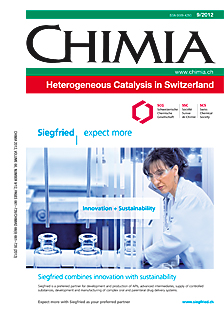Selective Alkyne Hydrogenation over Nano-metal Systems: Closing the Gap between Model and Real Catalysts for Industrial Applications
DOI:
https://doi.org/10.2533/chimia.2012.681Keywords:
Alkyne, Monodispersed colloids, Selective hydrogenation, Supported palladium catalystAbstract
The relationship between catalytic response and properties of the active phase is difficult to establish in classical heterogeneous catalysis due to the number of variables that can affect catalytic performance. Ultrahigh-vacuum surface methods applied to model catalyst surfaces are useful tools to assess fundamental issues related to catalytic processes but they are limited by the significant differences with catalysts in the working state. In an attempt to overcome this issue, (unsupported) nano-metal systems with controlled size and shape have been synthesized and tested in selective alkyne hydrogenation. The results revealed a dependency of nano-particles (NPs) morphology (size and shape) and allowed the identification of the active sites for this type of reaction. The nature of the stabilizer (steric and electrostatic stabilization) used in the NPs preparation has been shown to influence catalytic performance. The tailored active phase was subsequently immobilized on suitable nano- and micro-structured inorganic (e.g. 3D sintered metal fibers) supports with controlled surface properties in order to corroborate if the results obtained on the optimized nano-metal systems could be extrapolated to real catalysts. This article highlights the advantages and limitations of the analysis of selective alkyne hydrogenation over nano-metal systems that close the gap between model and real catalysts where the main challenges that lie ahead are summarized.Downloads
Published
2012-09-26
Issue
Section
Scientific Articles
License
Copyright (c) 2012 Swiss Chemical Society

This work is licensed under a Creative Commons Attribution-NonCommercial 4.0 International License.
How to Cite
[1]
Chimia 2012, 66, 681, DOI: 10.2533/chimia.2012.681.







